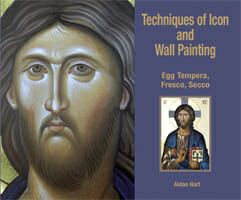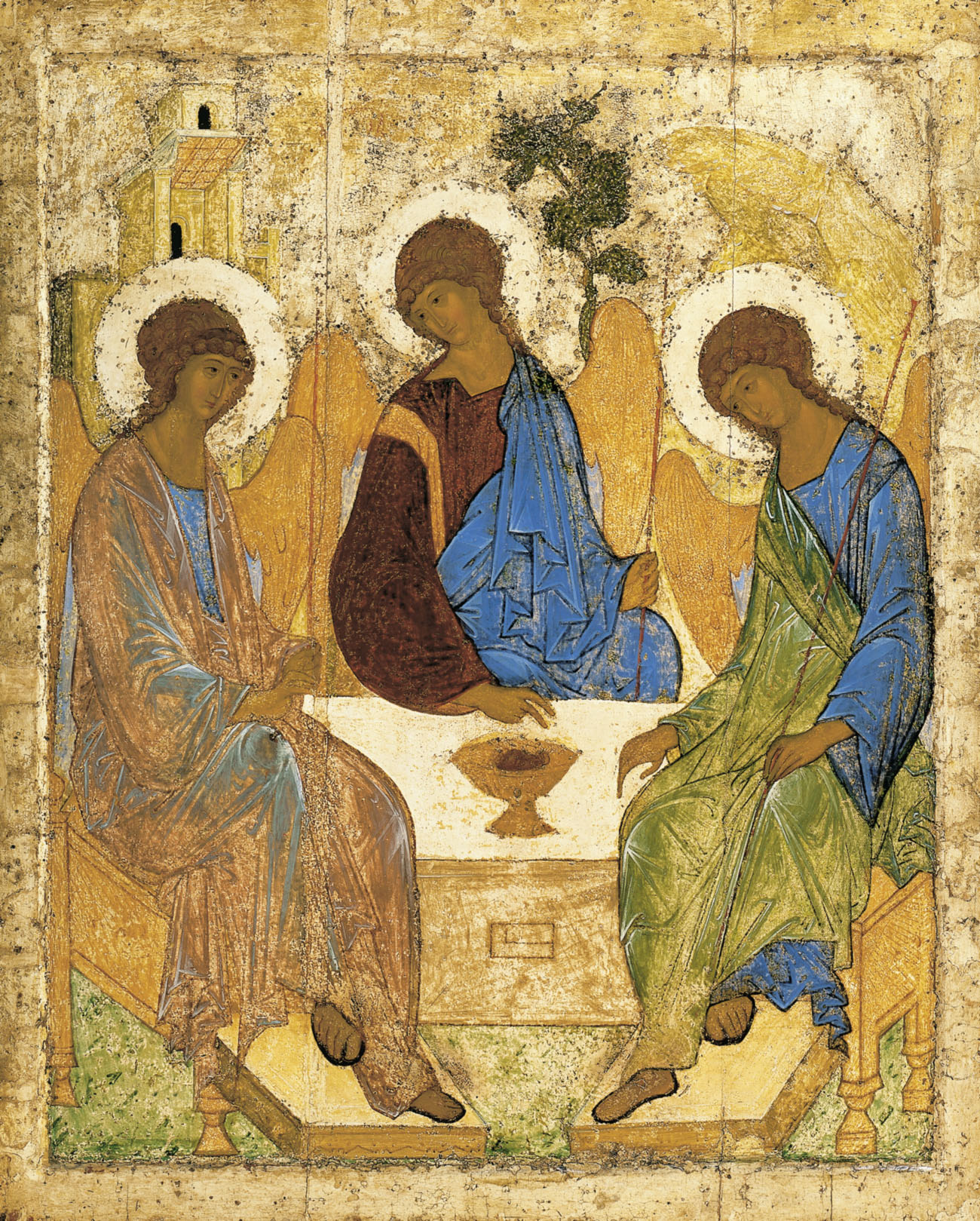Similar Posts
____________________________________________________________
 Editorial note: We have convinced Aidan Hart to post a chapter from his new book. “Techniques of Icon and Wall Painting” which is being hailed as the most comprehensive book to date on practicing the art of Iconography. At 450 pages, with 460 paintings, 150 drawings and covering everything from theology and design to gilding and varnishing, it is a prized possession for anyone interested in the traditional arts. The chapter being serialized over the next weeks is called “Designing Icons”. You will see why Archimandrate Vasileos of Iviron called this book the “Confessio of a man who epitomizes the liturgical beauty of the Orthodox Church”. More details about the book on Aidan’s website.
Editorial note: We have convinced Aidan Hart to post a chapter from his new book. “Techniques of Icon and Wall Painting” which is being hailed as the most comprehensive book to date on practicing the art of Iconography. At 450 pages, with 460 paintings, 150 drawings and covering everything from theology and design to gilding and varnishing, it is a prized possession for anyone interested in the traditional arts. The chapter being serialized over the next weeks is called “Designing Icons”. You will see why Archimandrate Vasileos of Iviron called this book the “Confessio of a man who epitomizes the liturgical beauty of the Orthodox Church”. More details about the book on Aidan’s website.
____________________________________________________________
This is part 7 of a series. Part 1, Part 2 , Part 3, Part 4, Part 5, Part 6, Part 7,
The icon aims not only to instruct us and offer a means of communion with the persons depicted, but also to initiate us into a more spiritual way of seeing the world. One of the ways it does this is through various forms of perspective that compel us to shift from a rationalistic perception. These systems are not irrational – that is, contrary to reason – but rather are supra-rational – beyond reason. To design an icon one needs some understanding of these perspective systems as used by the tradition, and the theological basis for them.
It is a common assumption that there is only one form of proper perspective, where straight lines converge on a point or points on the horizon. But this mathematical technique relates only to what we see with our physical eyes, which is why it was fully developed in the humanistic period of the Renaissance. In fact there are numerous other perspective systems available, which relate more to how we experience things than how our retina records them. With icons, the function of each perspective system is to help initiate the viewer into some particular aspect of spiritual vision.
As we have said, it helps to think of these other perspective systems as being supra-rational – not irrational or illogical, but on a plane higher than what the rational faculty can comprehend. Why should it be necessary to draw us beyond the rational faculty in this way?
The human person is not merely a body with a brain and sensory organs, but is also a spiritual being with spiritual faculties. We do of course possess a rational faculty, and this is God-given. This is called dianoia in the Greek, and rationare in the Latin. Its role is discursive, and it formulates concepts based on information received by it. For this reason it can know about things, but it cannot know things directly, in an unmediated way. Reason cannot know things as they are in their spiritual nature.
This knowing is the role of the highest faculty of man, called the intellectus in patristic Latin, and nous in patristic Greek. Writing in the eleventh or twelfth century, St Ilias the Presbyter affirmed that
By means of intellection the intellect [nous in the Greek] attains spiritual realities; through thought the reason [dianoia in the Greek] grasps what is rational. Sense-perception is involved with practical and material realities by means of fantasy.[1]
Through repentance (meta-noia in the Greek, a turning or changing of the nous) the person relinquishes a merely rational way of seeing and begins to perceive the inner essences (logoi in the Greek) of created things. This in turn is a stepping stone to meeting the Logos Himself. St Ilias explains it in the following way:
Incorporeal realities may be apprehended in the logoi or inner principles of corporeal realities; but in incorporeal realities may be apprehended the supra-essential Logos to whom every diligent soul urgently strives to return.
The inner principles [logoi] of corporeal realities are concealed like bones within objects apprehended by the senses: no one who has not transcended attachment to sensible things can see them.[2]
The style of an icon is designed to aid this turning or change by, as it were, throwing the rational faculty off balance so that the person must reach out to the noetic faculty in order to regain balance. The perspective systems in particular challenges us to go outside our comfort zone and to step into a realm where God is at the centre rather than our selves.
In this book we shall use the terms nous, noetic faculty, or the eye of the heart. Sometimes the nous is translated into English as mind or sometimes intellect, as in the English translation of “The Philokalia”. But unless clearly explained (as the translators of the Philokalia have done so lucidly in their Glossary), in our modern times the words “mind” and “intellect” are likely to be read as the brain or the rational faculty.
The term “eye of the heart” must be distinguished from the emotions, which, though God-given, have a different role in the human person. The eye of the heart, being an eye, sees objective realities, albeit ones invisible to the physical eyes. It is does not suffer from the vicissitudes and subjectivism common to the human emotions.
Ignorance of the noetic faculty and its role in influencing perspective systems was probably a major reason why art historians have sometimes lampooned non-mathematical perspectives as crude and folkish. If apart from the bodily senses all one believes in is the rational faculty, then indeed the icon and its perspective systems are folly. But if we are spiritual beings, then the icon is wisdom.
If we expose ourselves to icons long enough and with even a little openness, the various perspectives described below can open in the devout viewer this long closed “eye of the heart”.
Many of these perspective techniques are common to other traditions of sacred art – ancient Egyptian painting, for example, retains the flatness of the picture plane. Some of them are also found in the art of children, since they tend to draw or paint as they know or experience something, rather than simply as they see it with their physical eyes.
Under the name of skenographia, perspective was written about in Byzantium. Here the stated aim is the opposite of what later Renaissance artists attempted. In the fifth century Proclus wrote in his Euclid that skenographia was:
…the practice which teaches the artist how to ensure that something in his work should not appear distorted by distance or height.[3]
There is another important element of Byzantine thinking that effects its view on perspective. This concerns the correspondence of life with movement. Byzantines were not so interested in static symmetry, but as Plotinus put it, in “symmetry irradiated by life”. Geminus of Rhodes wrote in the first century B.C. that perspective (skenographia) allows an artist to make a work that will appear “eurhythmic to the eye of the beholder”, and rhythm presupposes movement.
I would suggest that the icon tradition’s emphasis on movement, balanced by the stillness of symmetry, is rooted in the fact that fullness is found in relationship, a continuous going out of oneself towards the other. Man is made in God’s image, and God is love, a relationship of the Persons of the Trinity. The divine dance of love, or perichoresis to give this its patristic description, is an eternal characteristic of God. God is of one essence, hence the symmetry and stillness of icons, and He is simultaneously a dynamic of love, the Persons of the Trinity united in an unmoving movement of love. This movement has been wonderfully expressed in the famous “Trinity’” icon by St Andrei Rubliof

It must be noted here that there are also arguments put forward that explain some of these perspective systems not as spiritually inspired but purely in terms of mathematics and optics. It was a common approach among Russian scholars of the last century, such a Lev. F. Zhegine.[4] His explanations are based essentially on the combining of the different views gained as the observer moves around the viewed object.
Discussion over the matter will probably go on forever, and remaining in the area of speculation will not be of great use to the practising iconographer. Form follows function however, so surely the fact that the icon tradition has consistently chosen these systems over naturalistic means is ultimately due to the icon’s spiritual and liturgical function; its aim is not merely to reproduce our optical experiences.
[1] “Gnomic Anthology, III:3, translation by G.E.H. Palmer et al in The Philokalia, Volume Three (Faber and Faber, 1995), page 47.
[2] Ibid. IV:85,86 (page 58).
[3] Quoted from Gervase Mathew’s work Byzantine Aesthetics, (London, 1965), page 5.
[4] Lev. F. Zhegine, Iazyk zhivopis’nova proizvednia (The Language of Pictorial Work), Iskusstvo, Moscow, 1970. For a précis refer to Egon Sendler’s “The Icon: Image of the Invisible” (California, 1988).

[…] https://orthodoxartsjournal.org/designing-icons-pt-8-the-theology-behind-iconographic-perspective…Thursday, Feb 28th 10:07 amclick to expand… […]